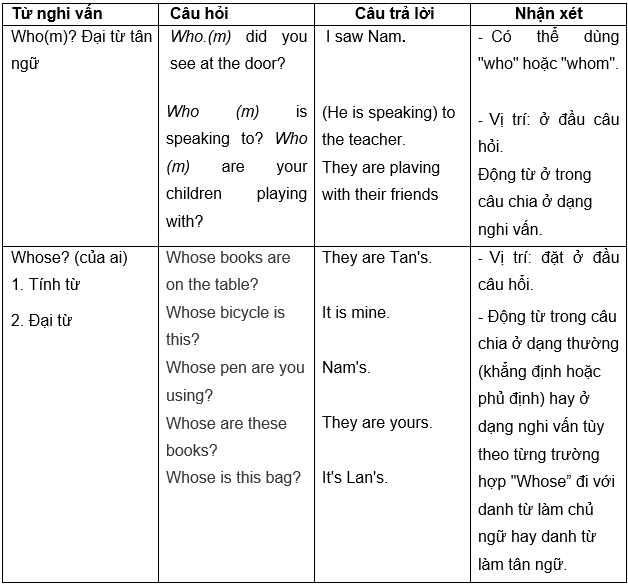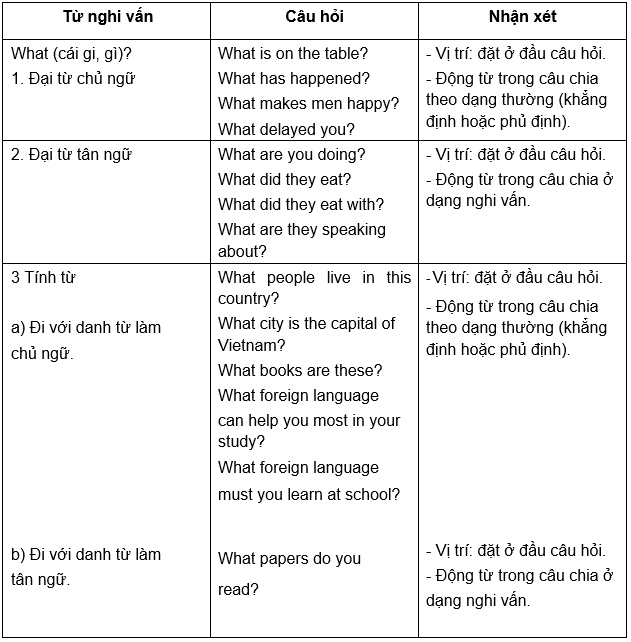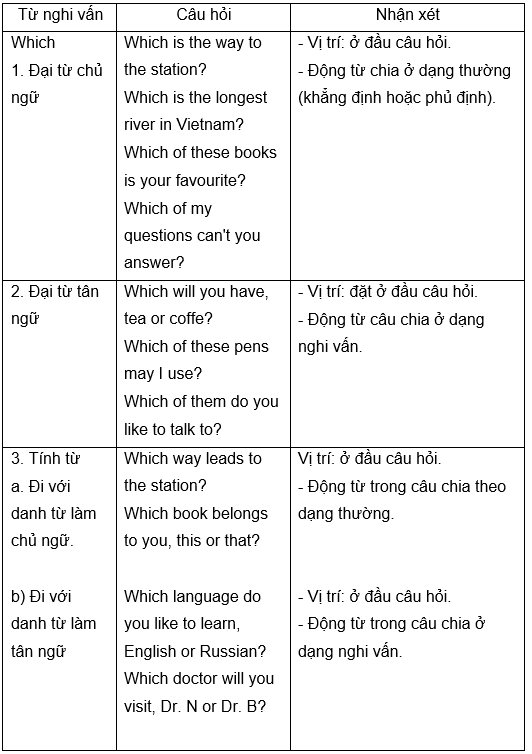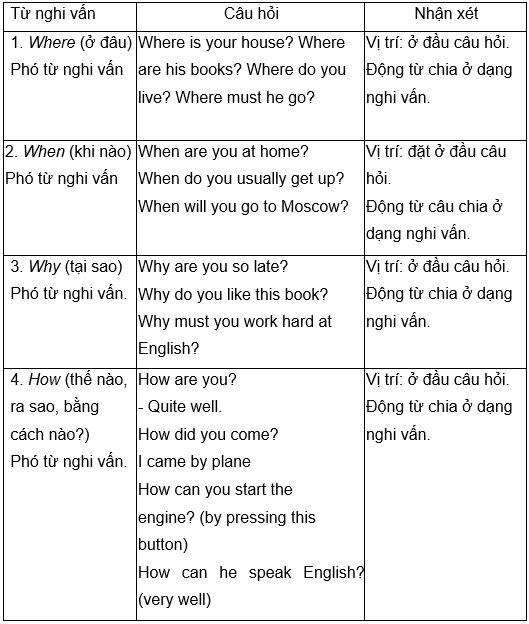TÍNH TỪ, ĐẠI TỪ VÀ PHÓ TỪ NGHI VẤN
(Interrogative Adjectives, Pronouns and Adverbs)
I. WHO, WHO(M), WHOSE

Bài tập
1. Dùng “who”, who(m), whose” đặt câu hỏi cho phân in nghiêng của những câu sau đây:
1. My brother helps me in my work.
2. We are speaking English to our teacher.
3. The children are playing in the school-yard.
4. He took his sons to the movies yesterday evening.
5. The pupils hats are on the shelves.
6. This is Lan’s pen.
7. She must take Mrs. Minh’s son to the kindergarden every morning.
8. He went with his father to Haiphong yesterday morning.
9. Nam is writing on the blackboard.
10. Lan and Huong are Mrs. Minh’s daughters.
II. WHAT

Bài tập
2. Điền vào chỗ trống bằng “Who, Who (m), Whose, What”.
1. … went with you to Haiphong last week?
2. … gave you those flowers?
3. … is yours friend’s name?
4. … is wrong with the clock?
5. … bus goes to Hadong?
6. … river flows through Hanoi?
7. … did you want to see?
8. … can I do to help you?
9. … pencil is this, Nam’s or Lan’s?
10. … is the matter with him?
11. … are they talking about?
12. … hat is on the table?
13. … school did she attend?
14. … would you like to drink?
3. Đặt câu hỏi cho phần in nghiêng của những câu sau đây.
1. The boy learned many subjects at school.
2. Minh taught me English.
3. The doctor told her to stay in bed.
4. That house is mine.
5. She has broken a glass.
6. I usually prepare my English lesson in the evening.
7. That tooth is hurting me.
8. I bought him a present.
9. The prize for the competition was a handbag.
10. I like to read English
11. Van has broken the window.
12. He met his old friend at the theatre yesterday.
4. Viết lại những câu sau đẩy cho hợp với lối nói thông thường (bằng cách đổi vị trí của giới từ).
Ghi nhớ:
Trong trường hợp đại từ nghi vấn (whom, what…) đi theo với giới từ, thông thường không nên để giới từ ở đầu câu hỏi trước từ nghi vấn.
Thí dụ : Không nên nói:
To whom is he speaking?
About what are they speaking?
Nên nói:
Whom is he speaking to?
What are they speaking about?
1. About what are you thinking?
2. At what are they looking?
3. With what are you cutting your pencil?
4. For whom are you waiting?
5. With whom is he playing?
6. In what room shall I sleep?
7. From what library did you get this book?
8. To whom does she want to speak?
9. Of what is butter made?
MỘT VÀI DẠNG CÂU HỎI VỚI “What” CẦN GHI NHỚ THÊM.
1. What … for?
a. Để làm gì (for what purpose).
What must you learn foreign languages for?
Anh phải học ngoại ngữ để làm gì?
What’s this money for?
Tiền này để làm gì?
Tại sao (why)
What did you do that for?
(có thể hiểu là:
Anh làm cái đó để làm gì?
Tại sao anh làm cái đó?)
2. What + (to be) + like?
Dùng để hỏi về tính chất hoặc hình dáng bề ngoài.
Có thể dùng để hỏi về cả người, vật, sự việc:
Thí dụ:
What was the weather like?
Thời tiết ra sao?
– It was very wet and cold.
Rất ướt và lạnh.
What was he like?
Anh ấy là người thế nào?
– He is a friendly sort of man.
Anh ấy là người cởi mở.
He is a tall man with a black beard.
Anh ấy là ngươi cao có bộ râu quai nón đen.
So sánh câu hỏi trên với câu:
What does he/ it look like?
Câu này ngụ ý hỏi về hình dáng bề ngoài.
Thí dụ:
What does he look like?
Anh ấy người như thế nào?
– He is tall and thin.
Anh ấy cao và gầy.
What does it look like?
Nó ra làm sao?
– It is white and puffy.
Nó trắng và sưng húp lên.
III. WHICH
Lời ghi: Which bao hàm một sự chọn lựa (có thể dùng để hỏi cả người lẫn vật). So sánh cách dùng giữa: who, what và which trong những câu sau đây:
1. – Who do you want to speak to? (có tính chất hỏi chung chung)
– I want to speak to Mr. Minh.
– We have two Smiths here: which do you want? (ngụ ý trong hai ngưòi thì anh muốn hỏi ai?)
2. – What will you have to drink? (hỏi chung chung)
– Beer.
– There’re beer, lemonade and milk, which will you have (ngụ ý lựa chọn trong ba thứ, anh muốn dùng thứ gì?)
– Beer.

Bài tập
5. Điền vào chỗ trống bằng những từ nghi vấn”Who, Who(m), What, Which”:
1. … boy won the first prize?
2. … did he go with?
3. … asked you to write this?
4. … is the healthier place the country or the sea-side?
5. … is the largest town in the world?
6. … is the way to the factory?
7. … of you can do this exercise?
8. … picture do you prefer, this or that?
9. … European language is the easiest to learn?
10. … hat is yours, this or that?
11. … has taken my pencil?
12. … of these girls is the youngest?
IV. WHERE, WHEN, WHY, HOW
Lời ghi: Where, when, why, how đều dùng làm phó từ nghi vấn.

Ghi nhớ: Một số câu hỏi với “How”

Bài tập
6. Dùng where, when, why, how… để đặt câu hỏi cho phần in nghiêng ở những câu sau đây:
1. His sister works at a factory.
2. I usually get up at five in the morning.
3. We must learn foreign languages because they are necessary for our work.
4. He didn’t go to school yesterday because he was ill.
5. We usually have dinner at eleven.
6. They live in the center of the city.
7. It takes him half an hour to do these grammar exercises.
8. His working day lasts eight hours.
9. He begins his work at 6 o’clock.
10. This bicycle costs 300,000 VND.
11. Every Sunday, my father takes me to the movies.
12. There are forty students in our class.
13. She is fifteen years old.
14. The playground is forty yards long.
15. He can come here by bus.
16. She can speak English very fluently.
17. I go to the library twice a week.
18. He always gets bad marks because he is very lazy.
19. He can swim two miles in an hour.




Comments mới nhất